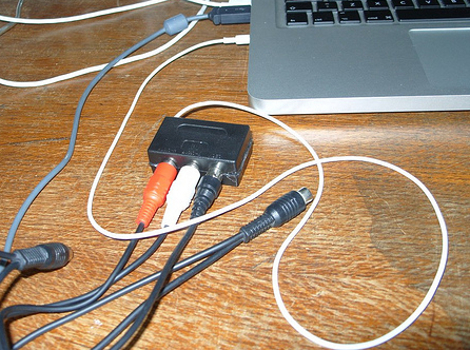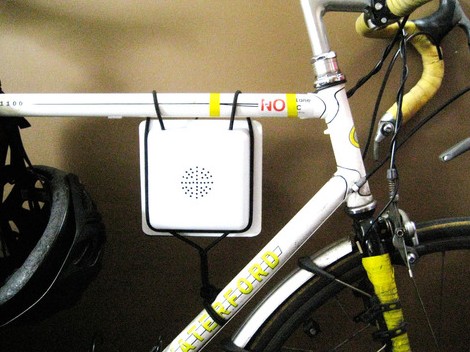[Oliver Nash] was enlisted by his parents to fix their robotic lawn mower. They owned a Robomow which happily navigated their yard to keep the grass at a nice level. These robots rely on a perimeter wire with a special signal running through it to ensure they are inside of the mowing area. Confronted by a dead perimeter module, [Oliver] ordered a new unit and disassembled the old module to study the components. He also measured the signal generated by the replacement unit. In the end he was able to produce a replica of the signal using audio software, burn it to a CD, and playback the recording using the perimeter wire. It’s a bit of a zany idea but it worked.
digital audio hacks745 Articles
Yukikaze, Music Visualizations
[youtube=http://www.youtube.com/watch?v=b4HtUwAkVDg]
[Taichi Inoue] put together this beautiful visualization system called Yukikaze, japanese for “snow wind”. Basically a spectrum analyzer, Yukikaze is delightful to watch. We would love to see what kind of response he gets, as most of the footage shows very slowly changing smooth jazz. While we don’t think he gets crisp EQ visualizations out of this since it is a single large chamber, we still think it is amazing to watch.
[via MakeZine]
Audio Breakout Box For MacBook Pro

[Billy] wanted to use the audio connector on his MacBook Pro for input and output at the same time. He knew it could be done because Apple sells headphones with built-in microphones that work with the computer. He set out to build a breakout box so that he could connect the components of his choice to the single port. Using a scart-RCA adaptor box he scrapped the scart plug and wired the RCA jacks to the Apple headphone wires. He can now patch the pickup of his guitar to the mic connector, send it through the MacBook, and run the output back to his guitar amp.
Velosynth Annoys Those Around You As You Ride

We’ve always put stock in ‘the quieter the better’ when it comes to road bikes. You’ll find this truth if you spend 100k on the back wheel of someone with a sqeaky rear derailleur. But apparently the folks at Effalo never learned this lesson as they’ve produced a bike computer that generates noise as you ride.
Perhaps it just takes some ingenuity to turn this into a beautiful music maker along the lines of the Force Trainer hack. No problem because the velosynth is a hackable design. The case was made with a vacuum form and inside you’ll find a bunch of small breadboards. The JeeNode, which is an Arduino/Xbee combination, serves as the heart of the device by taking speed and acceleration data from the bicycle wheel. From there it is passed on to various modules, Bob’s your uncle, and sound comes out. Check out their sales pitch after the break and if you’re starting to get some ideas about using this check out the open source info they’ve provided.
Continue reading “Velosynth Annoys Those Around You As You Ride”
Vuvuzela Removal

We’re hearing complaints everywhere about the noisemakers called Vuvuzelas during the world cup. Whether you are a fan of the sport or not, you can appreciate when a fellow hacker gets annoyed and start hacking. [Tube] has created a software filter that manages to remove the sound of the Vuvuzela from the videos. He shares the process of how it was all created, using Logic Express and a Mac mini (Google translation). Maybe this will also provide some relief from the constant stream of Vuvuzela whining as well.
[via DVice]
Massive MIDI Station Ditches The Monitor
[youtube=http://www.youtube.com/watch?v=8WQU-Lrm3D8]
Who need’s a touch screen when you’ve got 800 inputs each backlit with an RGB LED? This impressive controller was built by Ander for use in his performances. He did it with the intent to get rid of the computer monitor in his setup. We think there’s something to be said about that. It seems weird to go to a performance and see the artist staring at a screen the whole time. Unfortunately we don’t have too many details about the hardware but we can tell you that he’s using Ableton Live on the software side of things.
Wiimote Controlled Ruben’s Tube

While we could be content following our “kiddie d-day” as [Caleb Kraft] suggested. We know you can’t continue such an awesome Friday without trying to blow yourself up first.
This Wiimote Rubens’ tube caught our eye. A PVC Aluminum irrigation pipe is drilled with holes and propane is pumped through. A speaker on one end creates changes in pressure and a neat light show follows suit. [ScaryBunnyMan] went further though, with a collection of software and a Wii Remote he “plays god” controlling the music, and thus, the fire. Check out a fun video after the split.
[Via Make]











